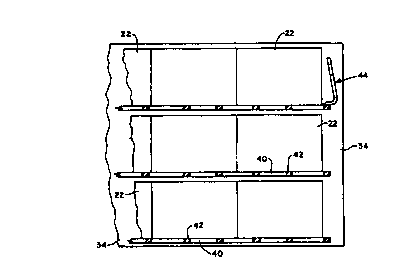Some of the information on this Web page has been provided by external sources. The Government of Canada is not responsible for the accuracy, reliability or currency of the information supplied by external sources. Users wishing to rely upon this information should consult directly with the source of the information. Content provided by external sources is not subject to official languages, privacy and accessibility requirements.
Any discrepancies in the text and image of the Claims and Abstract are due to differing posting times. Text of the Claims and Abstract are posted:
| (12) Patent Application: | (11) CA 2318220 |
|---|---|
| (54) English Title: | ROTARY REGENERATIVE HEAT EXCHANGER |
| (54) French Title: | ECHANGEUR DE CHALEUR REGENERATIF ROTATIF |
| Status: | Deemed Abandoned and Beyond the Period of Reinstatement - Pending Response to Notice of Disregarded Communication |
| (51) International Patent Classification (IPC): |
|
|---|---|
| (72) Inventors : |
|
| (73) Owners : |
|
| (71) Applicants : |
|
| (74) Agent: | SMART & BIGGAR LP |
| (74) Associate agent: | |
| (45) Issued: | |
| (86) PCT Filing Date: | 1998-09-03 |
| (87) Open to Public Inspection: | 1999-08-19 |
| Examination requested: | 2000-07-14 |
| Availability of licence: | N/A |
| Dedicated to the Public: | N/A |
| (25) Language of filing: | English |
| Patent Cooperation Treaty (PCT): | Yes |
|---|---|
| (86) PCT Filing Number: | PCT/US1998/018357 |
| (87) International Publication Number: | US1998018357 |
| (85) National Entry: | 2000-07-14 |
| (30) Application Priority Data: | ||||||
|---|---|---|---|---|---|---|
|
The heat exchange baskets (22) for a rotary regenerative air preheater are
loaded radially into the rotor (14) rather than axially from the duct end. The
rotor (14) is divided into sectors (20) by diaphragms (34), support gratings
(40) are provided in each rotor section (20) with the baskets (22) being
positioned and supported on the gratings (40). The baskets (22) are removed
from the rotor (14) with a removal lug or tool (44) which includes a lever
portion and a hook portion (46) with a beveled edge (50). The beveled edge
(50) and then the entire hook portion (46) are inserted under the outer edge
of a basket (22) and then rotated with the lever portion whereby the hook
portion (46) engages the basket (22). The lug or tool (44) is then pulled
outwardly to remove the basket (22).
Dans cette invention, les paniers d'échange thermique (22) d'un réchauffeur d'air régénératif rotatif sont chargés radialement dans le rotor (14) plutôt qu'axialement à partir de l'extrémité du circuit. Le rotor (14) est divisé en secteurs (20) par des membranes (34), des grilles de support (40) sont prévues dans chaque section (20) du rotor et les paniers (22) sont placés et maintenus en support sur ces grilles (40). Les paniers (22) sont retirés du rotor (14) à l'aide d'une barre ou d'un outil (44) de démontage, qui comprend une partie levier et une partie crochet (46) avec un bord biseauté (50). On introduit le bord biseauté (50) puis toute la partie crochet sous le bord extérieur d'un panier (22) et on fait tourner la partie crochet avec la partie levier, pour amener la partie crochet (46) en prise avec le panier (22). On retire ensuite la barre ou l'outil (44) de démontage vers l'extérieur, pour sortir le panier (22).
Note: Claims are shown in the official language in which they were submitted.
Note: Descriptions are shown in the official language in which they were submitted.

2024-08-01:As part of the Next Generation Patents (NGP) transition, the Canadian Patents Database (CPD) now contains a more detailed Event History, which replicates the Event Log of our new back-office solution.
Please note that "Inactive:" events refers to events no longer in use in our new back-office solution.
For a clearer understanding of the status of the application/patent presented on this page, the site Disclaimer , as well as the definitions for Patent , Event History , Maintenance Fee and Payment History should be consulted.
| Description | Date |
|---|---|
| Application Not Reinstated by Deadline | 2002-09-03 |
| Time Limit for Reversal Expired | 2002-09-03 |
| Deemed Abandoned - Failure to Respond to Maintenance Fee Notice | 2001-09-04 |
| Letter Sent | 2001-08-09 |
| Letter Sent | 2001-08-08 |
| Inactive: Cover page published | 2000-10-23 |
| Inactive: First IPC assigned | 2000-10-18 |
| Letter Sent | 2000-10-05 |
| Inactive: Acknowledgment of national entry - RFE | 2000-10-05 |
| Application Received - PCT | 2000-10-02 |
| Request for Examination Requirements Determined Compliant | 2000-07-14 |
| All Requirements for Examination Determined Compliant | 2000-07-14 |
| Application Published (Open to Public Inspection) | 1999-08-19 |
| Abandonment Date | Reason | Reinstatement Date |
|---|---|---|
| 2001-09-04 |
The last payment was received on 2000-07-14
Note : If the full payment has not been received on or before the date indicated, a further fee may be required which may be one of the following
Patent fees are adjusted on the 1st of January every year. The amounts above are the current amounts if received by December 31 of the current year.
Please refer to the CIPO
Patent Fees
web page to see all current fee amounts.
| Fee Type | Anniversary Year | Due Date | Paid Date |
|---|---|---|---|
| Basic national fee - standard | 2000-07-14 | ||
| Registration of a document | 2000-07-14 | ||
| Request for examination - standard | 2000-07-14 | ||
| MF (application, 2nd anniv.) - standard | 02 | 2000-09-05 | 2000-07-14 |
| Registration of a document | 2001-06-21 |
Note: Records showing the ownership history in alphabetical order.
| Current Owners on Record |
|---|
| ALSTOM POWER INC. |
| Past Owners on Record |
|---|
| MARK E. BROPHY |